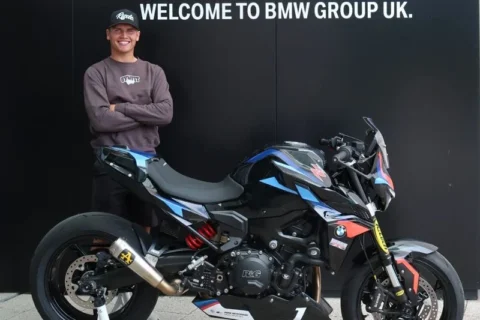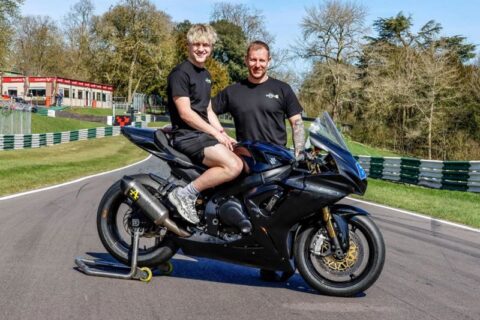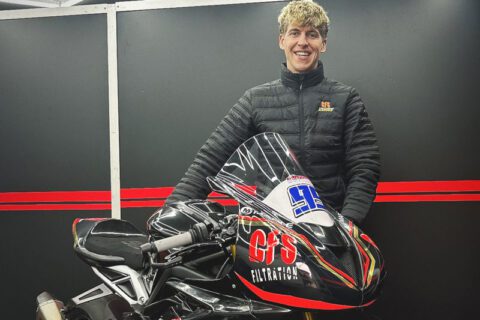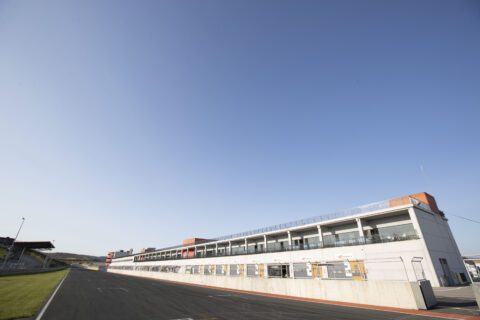Moto Rapido Ducati will add a Panigale V2 to its collective arsenal to compete in the 2023 British Superport series.
Under the next generation middleweight regulations, the 955cc V2 is allowed to compete alongside Triumph’s 765, MV Agusta’s 800 and the more regular four-cylinder 600s using balancing rules drawn up by the FIM’s resident Tefal Scott Smart.
We had a sit down with team principal Steve Moore to find out what the hell he thinks is getting himself into…
Wilf, you’ve spent quite enough money in BSB already. What is possessing you to spend even more money in Supersport?
Well, we were encouraged by Ducati, which is quite nice. Obviously, the TriOptions Cup comes to an end the end of this year, so there’s a small bit of the support that Ducati has been putting into that series that has been made available for this project, which is nice.
A few of our sponsors now are very keen on the idea, too. It’s considerably cheaper than racing a Superbike, so it makes is possible for us to have a good range. It’s not possible to expand to a second Superbike so with the Ducati now being eligible for the Supersport class it seems to make sense.
There’s not much new in racing, and the next generation Supersport stuff is very interesting. Lots of manufacturers are getting involved now too. It’s like Supersport has been a bit R6 Cup, the occasional MV and the occasional Kawasaki are doing well, if you’ve got the right pilot. So, with no new 600cc bikes now, it’s just been dull looking at the same bikes for 10 years. So, we have kept a close eye on what’s happing at World Supersport level and it seems the balance looks good with very close and fun racing.
Will you be the Oxford Products Racing, Moto Rapido Ducati longest name in pit lane team, or something else?
Oxford Products continues to sponsor the Superbike project for next year, as title partner, which is great. We may have a new title sponsor for the Supersport, but it will be one team. So, it will be somebody who is coming on board to help us out with the Supersport side, but Oxford will still be on the bikes, certainly. Same flavour and same colour bikes.
Have you got to expand the team to do this, or can you do it with your existing?
No, we’re going to expand the team. We’re fairly staff heavy as a one-rider team goes, but that’s because you need key staff like a data engineer, a chassis engineer, suspension man, whether you’ve got one bike or two. So, we’ve got one of each of those for one bike at the minute. So, some of the roles will swap over and they can handle both bikes, but we will have another couple mechanics and a tyre guy and tea boy and someone to polish your shoes and fly my helicopter.
Now we’re attracting sponsors that need hospitality we’ve already invested in that, so we can make use of the hospitality for the Supersport team sponsors and usual rider entourage. That’s why we can now bolt another racing class into the whole package really, without it being horrendously expensive. It doesn’t cost much more to feed a couple more riders and staff.
In terms of the bike, is there an awful lot of work to get that Panigale into the trim it needs to be? Or is it fairly easy?
We want to run it exactly the same way that we do the Superbike and build a bike to the extent of the rules, cover every detail, so there is a lot of work to prepare this bike to race trim. Also, at the minute, there’s no Superbike teams running Supersport bikes, that I can think of. It used to be that Supersport was the premium support class, if you like, and you’d have the teams running a Superbike and a Supersport. We want to run it in that same way.
I’ve had this conversation with a few people considering moving their bikes from the TriOptions Cup into Supersport. There’s a couple of ways you can do it, as with anything. Superbike is not Superbike and Supersport is not Supersport. So, you can either put an exhaust and an electronics kit and go and race, or you can build it to the extent of the regulations.
We’ll run the bike out of the garage. It will be run by the same team. It will be built to the same sort of specifications. A lot of the technical partners like Termignoni, Rock Oil, Spider and Braking brake discs and those sorts of guys will swap over onto the other bike as well. So, we’ll try and mimic the bike into a little Superbike, really. But there’s a fair bit of work.
Supersport bikes allow a fair bit of modification so it’s interesting to engineer, but nowhere near as much as a Superbike, so it’s a lot more cost-effective. The build of the bike is quite exciting. We’ve obviously been involved in what the factory is doing with Supersport at World Superbike. It’s quite a fun little project, really. We take on these little bikes and make it really good little track weapon with sophisticated suspension and electronics.
It’s not really a little bike though, is it?
Well, no. Physically they’re all the same size, I think. I think there’s a bit of a hang-up about the cubic capacity of these bikes. What I like about the next generation stuff is we’re getting away from it being a capacity-based class and more of a performance-based class. So, it doesn’t really matter what the CC of the bike is, how many cylinders it has got, whether it’s a 600 or a 400. The weight and performance will be similar, so it opens it up to many models of bikes, without manufactures making expensive homologation specials.
It doesn’t make any difference what the actual engine size is, in terms of displacement or layout. It just means performance. It’s literally how fast does the thing go. The balance in regs is now taking a lot of advantage of the technology available now so the twin cylinder bikes don’t have all the torque available. We can see in world championship that there isn’t really a clear performance advantage of any of the bikes now, the best riders are winning races.
Are the balancing regs exactly the same as World Supersport?
They are.
Presumably it’s a spec-ECU still?
Yeah. It’s a spec ECU, with spec-firmware for each model. Every model of bike is allowed different tuning options, I know the triumph changes a massive amount of the motor to make it work and be reliable. In the case of the Ducati which is too powerful as a showroom bike that means that the bike is electronically-controlled to reduce the power. So, just simply, with ride-by wire throttles, the rider has the throttle fully open on the grip, but he doesn’t get full power on the motor. That’s literally as simple as it is.
The application is simple but the numbers to which it opens to are much more complicated and based on gear, engine speed and vehicle speed, and that’s a job for Scott, not for me. So, I’m glad I don’t have that job. But he’s obviously got the balancing exactly right, because in World Supersport that’s exactly where it is. So, we’ll be on the same restrictions that they’re on and racing against Yamahas with the same regulations that the Yamahas are racing there. So, it should make for a good show.
For us, Supersport historically has been an expensive class to look at, because if you want to race a Ducati 748cc twin on old Supersport rules the bikes were getting a new engine every weekend because they’d last 300 miles. That just makes it obscenely expensive. I know some of the Japanese bikes don’t last more as they are tuned to within an inch of their lives. Some are lucky to get two weekends out of a BSB Supersport bike because they’re so highly-tuned.
So, it just makes it an expensive option to go racing, which is why you seen the growth in the series like Superstock 1000, and even Superstock 600. They can build the bike and then go race the thing and maybe change the engine once a year.
When I was club racing, I had a 748RS that I managed to get a hold of. They’re amazingly beautiful little bits of machinery and engineering, but you can’t turn your back on it for a second. It’s a mid- ‘90s Ducati. You start the bike, ride it, and then take it apart again and throw money at it… which is why nobody races them now. The Panigale V2 makes approximately 20hp more than the 748 RS did but with 800 per cent of the engine lifespan.
We look after seven or eight of the bikes in the TriOptions Cup, and those bikes coming to us might have literally almost like you’d service a road bike. You check the valve clearances, change the oil, check the pressures on the bike, change a couple of little pieces. But it’s not even taking the motor apart. It’s basic bits. Those bikes do a whole year on one engine and never think twice. To my knowledge, one has never blown up. I’ve never had an engine failure in the TriOptions Cup.
One of yours or at all?
Any of them. I haven’t seen one, ever. So, these guys are off doing track guys and club racing and everything with them. They’re not sat there being all precious about it like we are with our bikes. So, our plan for Supersport, we will use two motors for the whole season, which means it’s much, much cheaper to run the bike. Much less work. We’re not swapping motors every weekend.
I think people don’t quite realize when they watch the racing that the Superbike which starts the season is never the bike that finishes the season. Everything has changed like Trigger’s Broom. That’s why people struggle with Supersport, because it’s expensive to keep on top of. If they don’t, you see them parked up on the side of the track.
For comparison, how many engines do you get to run in the Superbike a year?
Not many because we are so limited for engine revs, our Superbike revs less than the street bike does, so we don’t hurt our motors at all… we use four engines. Including testing, in a season. In Superbike, we do about 450 kilometers a weekend. In Supersport, I think about 350, something like that. So, it’s a bit less. The V2 Supersport bike isn’t a tuned motor – these won’t be tuned in the slightest - they’re completely standard engines with an exhaust system.
And because they’re not tuned, because they’re not having the tits revved off of them, because they’re not at full throttle anywhere in a lap, they just don’t get stressed. They just don’t get abused. So, we’re hoping we won’t blow any up…
The logic is sound, bigger motors with much lower state of tune, same performance and less cost. It’s hard to see a downside unless you have a business tuning bikes and selling parts. Oh, wait…
And who is going to ride yours?
My word, is that the time? My dog ate it, I left it on the bus…










